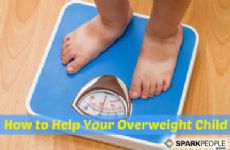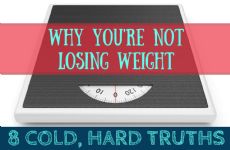|
From our partners at Woman's Day By Sara Reistad-Long Take a look around and it’s quickly obvious that too many of us weigh too much. Being obese may mean getting turned away from an amusement park ride or buying an extra seat on a plane, but perhaps more important, it endangers your health: Obesity is a risk factor for four of the six leading causes of death in the U.S. But what’s really alarming is that it’s no longer an anomaly. Between 1960 and 1980, the U.S. obesity rate held steady at 15 percent—but since then the numbers have spiked. Some studies show that if this trend continues, over 40 percent of us will be obese by 2018. The question is, why? “We’re not just turning into a nation of people with slow metabolisms,” says Lawrence Cheskin, MD, FACP, director of the Johns Hopkins Weight Management Center. Plenty of activists blame the food industry; unhealthy options are all around us and cheaper than ever. Other experts point to broader causes, from our sedentary lifestyles to how we think about food. “However you look at it, we’ve created a perfect storm of bad influences,” says David Ludwig, MD, PhD, director of the Optimal Weight for Life Program at Children’s Hospital in Boston and author of Ending the Food Fight. Luckily, as researchers uncover more and more about what these factors are and how they work together, they’re developing powerful strategies to counteract what’s contributing to our growing waistlines. Read on to find out how you can not only beat the scale but also help America beat the obesity epidemic. The Problem: We Eat More Than We Burn One thing we know for sure: If you consume more calories than you burn off, you’re going to gain weight. “Time was, people would come home from a long day of work having burned through a lot of calories, be it through manual labor or even just getting from one place to another,” says Dr. Cheskin. “Now, we’re mostly coming back from sitting at a desk in an office, having done things like drive a car and travel by elevator. We’re moving less, but still eating big meals.” What You Can Do: Make Your Everyday Life More Active Remember that every little thing you do, from tapping your feet to taking the stairs instead of the elevator, burns calories, says David Edelson, MD, FACP. Researchers believe that when we don’t move for hours on end, our whole metabolism slows down, so even a little motion (like walking to the water cooler) can counteract the effect. Along the same lines, there’s data showing that people who are natural fidgeters burn more calories throughout the day. To maintain a healthy weight, experts recommend getting at least 30 minutes of moderate-intensity exercise (think brisk walking) at least five days a week. But be aware: When you first become more active, you may feel hungrier, because your body is programmed to want to store energy. Account for this (and keep yourself from raiding the cookie jar) by planning healthy, small pre- and post-workout snacks, and figuring them into your overall daily caloric intake. The Problem: We’re Easily Influenced Obesity may not be a virus in the traditional sense, but, according to a landmark study in The New England Journal of Medicine, it can act like one by spreading through social circles. So if your friends and family are overweight, you’re susceptible as well. “We’re biologically programmed to take cues from our peers,” says Emily Levitan, ScD, assistant professor of public health at the University of Alabama at Birmingham. Some studies show that women will eat as much as 300 calories more when dining with their girlfriends. The phenomenon doesn’t end with our peer group. A recent study from UCLA uncovered a surprising twist in the TV/obesity connection. They found that the more commercials children saw, the heavier they were (watching commercial-free programming had no impact on weight). Seeing people eat huge amounts of, say, sugary cereals onscreen may have the same kind of effect as watching our friends dig into giant portions. An ad for food is also a double whammy: We’re being given the visual stimulus to eat and the time to go get food. What You Can Do: Choose (and Be) Good Role Models According to Dr. Ludwig’s research, entire families do indeed lose weight when they watch less TV. They also shed pounds when parents eat healthy (the kids mimic them). And countless studies have pointed to the effectiveness of losing weight as part of a group, or even blogging or tweeting about your diet. Feeling accountable to the people who are giving you support makes a big difference in losing. Thinking about how your habits influence others also makes a difference. “When we alter our habits altruistically—to help our kids, for example—it’s easier to do,” Dr. Ludwig says. And a recent Stanford study showed that students who started eating more healthfully to help the environment (cutting down on meat to reduce their carbon footprint, for example) fared much better than those who did it just for themselves. The Problem: Food is Cheaper Than Ever, So We’re Eating More of It Lack of activity, peer pressure— neither of these things would have this seismic impact were it not for one thing: Food is cheap. “In 1960, many people were spending as much as 24 percent of their income on food. When it’s that costly, you’re careful about what you buy. Today, many people are spending as little as 6 percent because food has become incredibly inexpensive,” says Brian Wansink, PhD, author of Mindless Eating and director of the Cornell Food and Brand Lab. In other words, as the cost of food has plummeted, so has the way we value it. We eat more and are less selective about our choices. What You Can Do: Scale Way Back on Portions After examining every edition of Joy of Cooking, Dr. Wansink determined that calories per serving have increased by an average of 35 percent since 1936, when the book was first commercially published. Restaurant portions are believed to have grown by about the same amount. Knowing this is a powerful tool. First, you need to readjust your eye to what healthy portions look like. (Go to womansday.com/cheat for our cheat sheet.) Another eat-less tactic: At home, try eating your meals on smaller plates—a salad plate, for example. Studies show that when people use smaller dishes, they take smaller servings and eat less. When you order an entrée at a restaurant, split it in half. Or get an appetizer instead. Slowly, your stomach will get used to the smaller portions and you’ll feel full on less. The Problem: Our Foods are Filled with High-Calorie, Hunger-Driving Ingredients There is, of course, another part to the cheap-food equation. “Our diet has been invaded by high-calorie, poor-quality commodities,” says Dr. Ludwig. “Wheat, soybeans and especially corn have been subsidized by the government—so there’s an abundance of simple carbs, unhealthy oils, and of course high-fructose corn syrup floating around.” When certain ingredients started flooding the market at cheap prices, food companies found ways to use them to replace more expensive options. High-fructose corn syrup (HFCS), for example, costs so little that producers will often add liberal amounts of it to foods that, in the past, would have gotten a bare minimum of real sugar. Today you’ll find HFCS (and the extra calories it brings) in everything from bread to chicken nuggets. The same thing is happening with soybean oil. The excess calories and fat these ingredients add is only part of the problem. “Sugars, fats and salt— all the things you get a lot of in packaged foods—don’t just taste good; they’re believed to drive appetite in a way that’s almost primitive,” says Dr. Levitan. “In previous generations, fat, sugar and salt were rare. So we have a biological drive to binge on them when we get the chance.” In fact, research supported by the National Institute on Drug Abuse has found similarities between the neural mechanisms underlying compulsive eating and cocaine addiction: People get a taste of these sweeteners and fats and have trouble stopping. What You Can Do: Satisfy Your Hunger with Nutrient-Rich Whole Foods Minimize the amount of packaged foods you eat, and when you do choose them, stick with foods that have as short an ingredients list as possible. More ingredients almost always means more processed— particularly if you can’t pronounce the names. Not only are packaged foods full of unnecessary additives, they also have few, if any, nutrients. The more a food is refined, the more nutrients it loses. Research is showing that when we eat empty-calorie foods that don’t provide adequate vitamins and minerals, our satiety signals don’t get activated—so we keep eating more. The flip side: Fill your diet with nutritious food, and you’ll naturally eat less. Want proof? One Chinese study found that women who were given a daily pill that (unbeknownst to them) contained essential vitamins and minerals ate fewer calories and lost more weight than those who got a placebo. The Problem: We Over-Diet Four out of five American dieters regain weight they lose, a fact that’s got experts reevaluating our approach to curbing how much we eat. “You could liken traditional diets to telling people to think about breathing; as soon as you do that, the process feels unnatural and hard to do,” says Dr. Edelson. Think about it: Most of our strategies have involved some kind of counterproductive deprivation. In the 1980s, for example, it was all lowfat and low-cholesterol. We later learned that cholesterol-rich foods like eggs and shellfish have a minimal effect on cholesterol in the body. However, huge amounts of pasta and similar carbs—what people were eating to compensate for the fat—actually make the liver produce large amounts of triglycerides and excess cholesterol. Similarly, snacking was, for generations, a diet “don’t,” but we now know that long stretches of time between meals cause the body to go into starvation mode, hoarding fat and calories. What You Can Do: Find a Healthy Way of Eating That Works for You Most people think of dieting as temporary, says Dr. Wansink. “But we need rules we can stick to for life or we’ll cheat or work around them.” The one style of eating that time and again results in healthy body weight is a plant-based Mediterranean one, rich in healthy fats like those from avocados, nut and olive oils, fruits and vegetables, whole grains, nuts and lean proteins. Globally, countries whose populations eat this way have lower rates of obesity and heart disease than other parts of the world. And just this past spring, the Journal of Women’s Health reported that 80 percent of American women who used this approach lost more than 5 percent of their weight compared with 31 percent of women following a lowfat diet. Experts believe that the balanced nutrition it provides satisfies our system so we’re not left with such strong cravings. The Problem: Eating When We’re Stressed, Depressed or on the Go Has Become the Norm “When we’re stressed, we turn to food to feel better, which is a double whammy because the physical effects of stress, such as increased levels of cortisol, tend to cause weight gain,” says Dr. Edelson. Perhaps, adds Dr. Cheskin, this is because as a society, the way we eat these days is quite different from the way most of us did growing up. “We eat more frequently by ourselves now, whereas before, meals were a structured occasion.” We still associate food with love, safety, and comfort—but believe it or not, recent research shows that just 38 percent of Americans eat dinner with their families more than three times a week. What You Can Do: Put Some Time and Effort Into Eating and Tune in to Your Hunger It takes about 20 minutes for the “I’m full” signal to get from the stomach to the brain. During a sit-down meal, where the chewing is interrupted by conversation (and we’re ideally surrounded by others who are eating healthfully), that’s plenty of time for our brains to get the message so we stop eating. But alone, on the go or in front of the TV, it’s all too easy to polish off an entire bowl of mac and cheese before that message has time to get where it’s going. And when we’re stressed or depressed or anxious, that’s exactly what many of us are likely to do. Experts estimate that 75 percent of overeating is caused by emotions. And data from the Eating Disorders Program at the University of North Carolina found that stress, loneliness, anxiety, anger, guilt, sadness, even boredom are all connected to overeating. “We’re all in this obesity problem together,” says Dr. Ludwig. “The best thing you can do is get together and cook with your loved ones. Preparing meals together not only lowers the cost, it also turns food back into something special and worth savoring slowly.” 8 Common Weight-Loss Myths—Debunked 10 Reasons Your Body Thinks It's Hungry 8 Amazing Blogger Weight-Loss Transformations What do you think is to blame for the obesity epidemic? |
Related Entries
More From SparkPeople
|




.jpg)

















